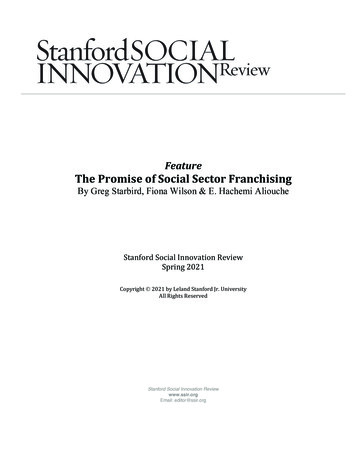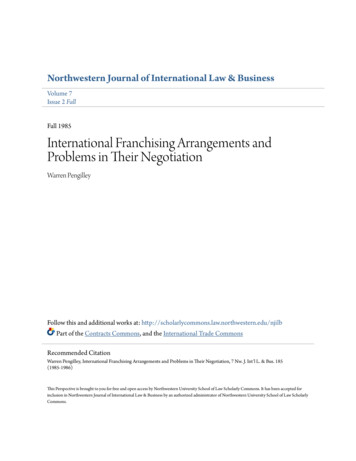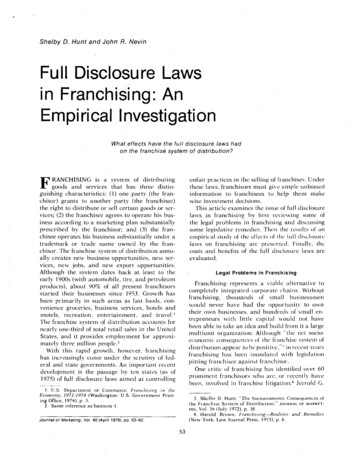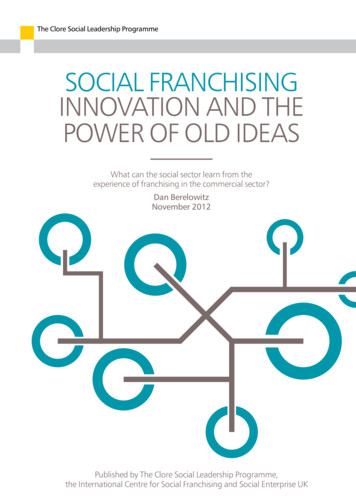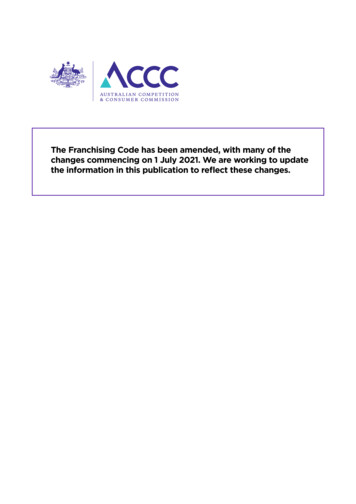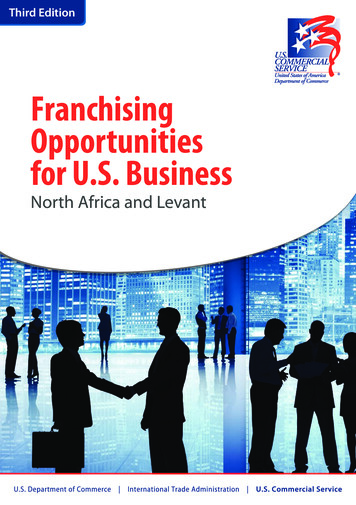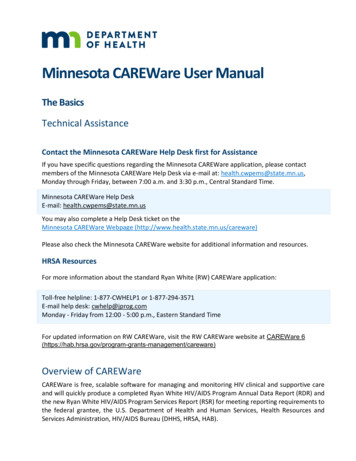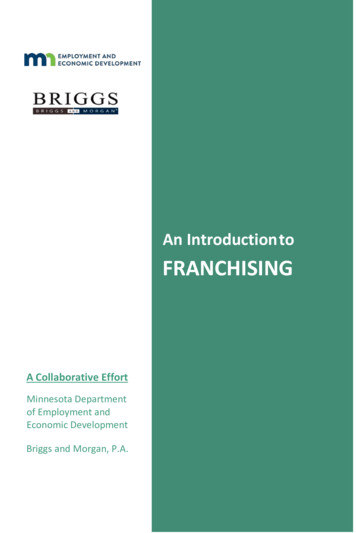
Transcription
m IIEMPLOYMENT ANDECONOMIC DEVELOPMENTBRIGGSti HI I, C, ',IVI) I , ;,:-,J 'An IntroductiontoFRANCHISINGA Collaborative EffortMinnesota Departmentof Employment andEconomic DevelopmentBriggs and Morgan, P.A.
An Introduction to Franchisingis available without charge from the Small BusinessAssistance Office, 1st National Bank Building,332 Minnesota Street, Suite E200, St. Paul, MN 55101-1351.Telephone: 651-259-7476 or 800-310-8323Email: deed.mnsbao@state.mn.usWebsite: Small Business Assistance Office
An Introduction ToFRANCHISINGThird EditionJanuary 2008Andrew C. SeldenRobin Caneff GipsonAmanda B. ParkerA Collaborative EffortMinnesota Department of Employment and Economic DevelopmentBriggs and Morgan, P.A.Copyright 2008 Minnesota Department of Employment andEconomic Development and Briggs and Morgan, P.A.ISBN 1-888404-48-5
TABLE OF CONTENTSTHE BUSINESS OF FRANCHISING.1Method of Distribution.1Business Format Franchises – Product.2Business Format Franchises – Services.2Product Franchises.2Affiliation Franchises.2Method of Expansion.3Other Business Goals.4Multiple Forms of Franchising.5Investment Opportunity.5Economic Impact.6Negotiating a Franchise.6Business Opportunities Laws.7HOW TO RECOGNIZE A FRANCHISE.8Why This is Important.8Receiving Pre-Sale Disclosure.9Protecting a Business Relationship.9Escaping a Business Relationship.10Avoiding the Creation of Inadvertent Franchises.11Statutory Definitions.12Minnesota Law.12Exemptions from the Registration Requirement.19Federal Trade Commission Rule.19Other States.21Common Characteristics of Franchises.22Business Opportunities Laws.23i
FRANCHISE REGULATION .26History.26Registration and Disclosure.28Cooling Off Provisions.34Financial Conditions to Registration.34Other Contracts.35Material Changes to Form Agreements.36Negotiating a Franchise.36Additional Franchises.37Sales by Franchisees.37Franchise Relationship Regulations.38Other Franchise Classifications.39CHOOSING FRANCHISING AS A METHOD OF DISTRIBUTION.40Planning a Distribution Program.40Suitability of Franchising.42Advantages and Disadvantages of Franchising.42Advantages of Franchising.43Disadvantages of Franchising.45FRANCHISEE CONSIDERATIONS IN EVALUATING A FRANCHISE.49Advantages and Disadvantages of Franchising.49Advantages.49Disadvantages.51How to Evaluate a Franchise Offering.56Risk Factors.57Upside Opportunity.59RIGHTS WHEN THINGS GO WRONG.61For a Franchisee.61For a Franchisor.62ABOUT THE AUTHORS.64ii
THE BUSINESS OF FRANCHISINGFranchising is perhaps one of the most widely misunderstood phenomenain American business. Judging from coverage in the popular media, forevery story of wild success – every McDonald’s or Holiday Inn – thereseems to be a story of a crashing failure, or even outright thievery, allcarried on under the banner of “franchising.”Franchising is frequently, but erroneously, described as an “industry.” Ithas been characterized both as the enemy of the American entrepreneurand as the “last, best hope” of American small business to competeagainst integrated chain retailers.Can franchising be all of these things? Is it any of them? The answer is“yes.” It has been virtually all of these diverse things, in different timesand at different places, and in different manifestations. What franchisingreally represents is a powerful business tool to distribute goods andservices, and to expand a business. It can be a potent investment devicefor franchisees.This book provides an overview of franchising as a business tool andthe limited public regulation of franchising. It seeks to give the readera starting point for understanding franchising and evaluating franchiseopportunities.METHOD OF DISTRIBUTIONFranchising is primarily a method of distribution of goods or services.In this sense, franchising is simply a business technique, a means ofdistributing or providing goods or services to the consumer. Franchisingappears in four primary modes:1
Business format franchises for products:These are businesses where the franchisor does not actually producea product but instead dictates to a franchisee how to conduct a businessproviding a prescribed product to consumers. Examples includefranchised quick service restaurants and automotive aftermarket supportbusinesses.Business format franchises for services:As in business format product franchises, the franchisor does not itselfactually produce or provide a service for resale, but dictates to thefranchisee how to conduct a business providing prescribed services toconsumers. Examples include franchised motels, quick printing shopsand home cleaning services. Even nonprofit service organizations can usethis form of franchising to expand the reach of their programs into newcommunities.Product franchises:In product franchises, the franchisor itself manufactures and distributesa tangible product offered to consumers through franchised retaildealerships, where the franchisor/manufacturer also dictates to thefranchisee/dealer how to conduct the dealership business. These may befound not only where the franchisor itself manufactures the product,but also where it has products produced for its account by a third party,or acts merely as a distributor of products whether or not it actuallyhandles the physical distribution of them. Examples include franchisedice cream “dipping shops,” soft drink bottling companies, chain hardwarestores, and some specialty merchandise retailing chains.Affiliation franchises:An affiliation franchise is a uniquely American business phenomenon.The franchisor recruits into its franchise system (in almost any businesscategory, offering goods or services) a retailer who is already engaged, asa successful independent operator, in the franchisor’s line of business.Examples include some of the franchised real estate brokerage chains,some franchised health care providers, and franchised travel agencysystems.2
METHOD OF EXPANSIONIn addition to being a method of distribution, franchising is also usedas a method of expanding an existing business. In this sense, we aresimply looking at franchising from a different perspective: namely, thatof a business seeking ways to expand the scale of activity in which it isengaged.Franchising used as a method of expansion is an alternative means ofcapital formation. A business seeking to expand the scale of its operationsneeds growth capital. Traditional ways of raising such capital includeventure capital lenders, various forms of bank and commercial financing,or public or private placement of securities through investment bankingchannels. Franchising may be thought of as an alternative to thesemore traditional means of raising growth capital. Using franchising, thebusiness in effect appropriates to its enterprise the capital, as well as themanagerial talent and effort, of the franchisee. This is most commonlyaccomplished by inducing franchisees to invest in additional retailoutlets, usually in new geographic market areas, but all in support of andcustomarily identified by the franchisor’s trademarks. The franchisee,therefore, makes a significant capital contribution to the strengtheningand expansion of both the scale and the goodwill associated withthe franchisor’s business enterprise and brand.To be sure, capital formation through franchising entails some significantequity trade-offs. This is discussed later in “Choosing Franchising as aMethod of Distribution.”Franchising as a method of expansion is especially attractive to a businessseeking to expand into foreign markets or markets that are geographicallyor culturally remote from the franchisor. This would be every bit as true fora Minnesota-based company seeking to expand into Texas or California asit would be for expansion into Canada or Europe, or for a foreign businessseeking an effective means of penetrating the U.S. market.3
Finally, because of its inherent capital and managerial leverage, franchisingis often attractive as a means of expanding a business more rapidly thanmight otherwise be possible. Rapid growth is a goal often cited by firmsthat elect to expand using franchising.OTHER BUSINESS GOALSFranchising sometimes is attractive to a business not as a primarybusiness goal, but as a means to other ends. In this mode, franchising canbe a catalyst to the achievement of other, more primary, business goals.A company may find that for technological, regulatory, or other businessreasons, it is desirable for the manufacturer to attain a much higher levelof presence or involvement in retail operations involving its products orservices than might otherwise be the case. The business, nevertheless,cannot always afford or even desire to vertically integrate its distributionprogram by owning the retail level of operation. For such companies,franchising can be an attractive compromise. It provides many of theadvantages of equity ownership of a retail operation but avoids much ofthe capital cost and managerial responsibility that can be burdensome tocompanies lacking unlimited capital.One example of such a business would be a manufacturer of a high techproduct who determines that demonstration, sale, installation, and aftermarket customer support of its products dictate a more “hands on”presence by the manufacturer than would be possible through the use ofunaffiliated, independent wholesalers and retailers. A second example is acompany selling products that have significant consumer safety or publicregulatory implications. For those reasons, the company might choosenot to place its product in the hands of independent and essentiallyuncontrolled retailers. In both cases, franchising offers an attractivemiddle ground between merely selling the products to distributors orwholesalers for unconstrained, unsupervised redistribution, or a verticallyintegrated, “company owned,” retailer network.4
MULTIPLE FORMS OF FRANCHISINGFranchising takes many forms. Across the primary modes of businessformat franchises, product franchises and affiliation franchises, franchisingis found in an almost limitless variety of structural arrangements. Theseinclude traditional single-unit retail franchises, multiple-unit franchises,franchises with or without exclusive or protected territories, franchiseswith or without growth options or rights of first refusal, trade areafranchises, mobile and home delivery franchises, and one or moretiered subfranchising arrangements. A variety of hybrid ownershiparrangements, such as joint ventures and other shared equity businessarrangements, also appear in franchise systems.INVESTMENT OPPORTUNITYFranchising can be viewed from another major perspective: that of theprospective franchisee, to whom a franchise may represent a shortcutto establish a new business opportunity. For many Americans, thedream of autonomy and financial independence associated with owningand operating one’s own business provides a motivating goal, but oneof somewhat daunting proportions. Forgoing the relative security andcomfort of a salaried position with a larger business entails significantrisk.Franchising offers a middle ground between salaried employment and theessentially open risk of launching one’s own independent small business.Again, franchising in this manifestation involves significant trade-offs,discussed later in “Considerations in Buying a Franchise.” Nonetheless,it offers the potential to reduce the risk of business failure and loss ofinvestment associated with launching an unfamiliar new business.Increasingly, even very large business organizations choose franchiseinvestment as a shortcut to entry into an unfamiliar line of business.It provides faster and easier brand recognition than might be possiblethrough internal development of a house-branded line of business.For example, Target Stores might invest in a Subway or McDonald’s5
franchise, or Marriott in a Pizza Hut franchise. Franchised national brandsare increasingly prevalent in institutional host entities such as airports,museums and schools.ECONOMIC IMPACTFranchising is a major contributor to the growth of the U.S. and worldeconomies. The International Franchise Association believes that as manyas 750,000 franchise businesses operate in the U.S., employing more than15 million Americans. Franchising generally accounts for as much as 50percent of all U.S. retail sales (including motor vehicles and motor vehiclefuel). Franchise businesses (again, including motor vehicles and fuel) arenow responsible for more than 1.5 trillion in retail sales. These figuresare growing at a steady annual pace, roughly in proportion to the rate ofexpansion of the U.S. economy as a whole.In foreign markets, franchising represents a major constituent in thegrowth of U.S. foreign trade, contributing steadily to stabilizing thenation’s foreign trade deficits. Studies indicate that as many as 450 U.S.companies offer franchise programs with more than 35,000 outlets innumerous foreign countries. Many U.S. companies increasingly dependupon foreign franchising for continued growth in sales, earnings andshareholder value.In this context, it is worth noting again that franchising is one of the bestpossible tools for U.S. businesses to use to enter foreign markets, and forforeign businesses to enter the American marketplace.NEGOTIATING A FRANCHISEWhile some franchises are offered on a “take it or leave it” form contract,most are negotiable to one extent or another. Franchises offered bysmaller or start-up franchisors are usually susceptible to some degreeof negotiation to accommodate the franchise offering to the needs andmarket circumstances of the prospective investor.6
“BUSINESS OPPORTUNITIES” LAWSAnyone interested in franchising must also be aware of public regulationof a distinct but related business phenomenon known as “businessopportunities.” This subject is generally outside the scope of this book.Briefly stated, a business opportunity is a business investment programin which the seller of the opportunity offers to provide goods or servicesto the buyer to enable the buyer to start a business, and the seller assuresthe buyer that the business opportunity is essentially free of risk, based ona variety of features. For example, the seller may make representationsthat it will (1) find locations for racks or vending devices for selling theproducts produced or distributed by the business opportunity buyer;(2) “buy back” the buyer’s output of goods or services produced withmaterials or assistance provided by the seller; or (3) refund the buyer’spayments or investment if the buyer becomes dissatisfied with theinvestment. Or, the seller may indicate that a market is assured for thebuyer’s output of goods by virtue of a “marketing plan” to be provided bythe business opportunity seller.Although business opportunity regulation was an outgrowth of a numberof often fraudulent “business” scams, such as chinchilla ranches, wormfarms, “work-at-home” schemes and other dubious arrangementspromoted to naive and unsophisticated consumer investors, the law nowsweeps in a much broader array of business and distribution programs.Today, many legitimate businesses use structured business arrangementsthat are classified as “business opportunities” under one or more states’laws. Business opportunity regulation is discussed further in a latersection.7
HOW TO RECOGNIZE A FRANCHISEWHY THIS IS IMPORTANTFranchising is a regulated form of doing business. Under Minnesotalaw, a franchisor may not offer or sell a franchise until the offering isregistered with the Minnesota Department of Commerce, or qualifies foran exemption from registration. Once the offering is registered (or if itis exempt from registration), the franchisor may sell a franchise only ifit first provides a comprehensive presale disclosure document to eachprospective franchisee. The disclosure document historically has beencalled an “offering circular” or “UFOC” (for “Uniform Franchise OfferingCircular”), or “franchise disclosure document.” Under a 2007 change in aFederal Trade Commission rule on franchise disclosure (discussed later),the “franchise disclosure document” (or “FDD”) terminology will comeinto wider use.Minnesota law also provides an umbrella of protection to franchisees byprohibiting certain listed “unfair practices.”Failure to comply with the law — by failing to register; by providing a false,misleading or incomplete offering circular; or by violating the unfairpractices rules — exposes the franchisor to substantial penalties and civilliability to an injured franchisee. Any entity engaged in distribution ofgoods or services, or licensing of any kind, should learn the reach of thislaw to avoid a costly and embarrassing violation.For someone buying into a business promotion of any kind, awarenessof the existence and scope of the franchise laws assures access to bothimportant investment information and strong laws protecting franchiseeinvestors.8
Consequently, people involved in business from almost any perspectiveshould learn to recognize franchise arrangements. Discussion of the fourmost important reasons follows.Receiving Pre-Sale DisclosureA prospective franchisee is entitled under Minnesota and federal lawto receive comprehensive pre-commitment disclosure of materialinvestment information from the franchisor. The investor should alwaysconsider whether or not the business is a franchise when contemplatinginvestment in a business promoted by another. This will alert the investorto a variety of important considerations, including his or her entitlementto receive this comprehensive pre-commitment disclosure.Investment commitments to a franchise offering should not be made untilthe required pre-commitment disclosure information has been received,studied carefully, and reviewed with a professional advisor.Pre-commitment registration and disclosure of franchise offerings iscovered in much more detail below. For now, simply note that even forcompanies that have recognized and properly treated their businesspromotion as a franchise, the quality of disclosure information variessignificantly between offerings. For many other types of businesspromotions, the investor can recognize a critical danger signal if he orshe can recognize that a particular business proposition does (or could)constitute a franchise under Minnesota state law, but the promoter hasnot treated the offering as a franchise.Thus, investors have a meaningful incentive to watch for businessopportunities that may constitute a franchise even if the seller does notrealize that its proposal constitutes a franchise.Protecting a Business RelationshipFranchise law can provide recourse for a party already in a businessrelationship with another party which the other party proposes toterminate or to alter significantly to the detriment of the investor. If the9
investor whose interest is being threatened recognizes that thebusiness relationship fits within the statutory definition of “franchise,”the investor sometimes can rely on these powerful legal tools toprotect the relationship against unwarranted termination or certainother disadvantageous changes in the relationship.This happens because in Minnesota (as well as Iowa, Wisconsin and about14 other states), legislation provides a range of remedies to investors infranchises. These remedies protect against practices including terminationwithout good cause and refusal to allow the investor to exercise arenewal or extension option. In some states, including Minnesota, thelaw prohibits a wide variety of additional “unfair practices.”Invoking these legal rights requires the assistance of an attorney tointerpret the law and its possible application to your particular factsand circumstances. But investors should be aware that state law mayprovide a means to resist an unwanted termination or a material, adversealteration of the business relationship.Oftentimes, dealership or distributorship-type relationships are createdby parties who are unaware that the relationship might be governedby state franchise law. When this occurs, the franchisee may be able touse statutory remedies afforded to the franchisees, long after therelationship was established, even though it never occurred to anyoneearlier that the business arrangement constituted a franchise.Escaping a Business RelationshipConversely, franchisees sometimes can use state franchise laws to escapea business relationship that proves to be unsuccessful or materiallydifferent from what had been anticipated.If the business arrangement was treated as a franchise from the outset,the franchisee will be well aware of the applicability of state franchiselaws. If the nature of the business established by the franchisee,the level of support services provided by the franchisor, or the amount10
or type of investments required to establish and operate the businessturn out to be materially different from what was represented in theoffering circular, the franchisee may have a claim for damages. Thefranchisee also may be able to rescind the sale of the franchise based onthe misdisclosure. Similarly, investors in business arrangements that laterprove to be franchises, but weren’t treated as such at the outset, mayinvoke the franchise laws to rescind the relationship even if an otherwisebinding contract is in place, or to recover damages and other appropriaterelief.The law also provides that the franchisee may recover its legal fees incertain cases.Evaluating such an action involves the application of a complex statutoryscheme to infinitely variable sets of facts and circumstances. This requiresthe assistance of a legal advisor. Awareness of these remedies, however,always must begin with the operator of the business.Avoiding the Creation of Inadvertent FranchisesA business seeking to expand, or seeking outlets for its products or servicesthrough distributors or dealers, may inadvertently create a franchiserelationship. This happens when a party enters into an arrangementwith another that meets the statutory definition of “franchise” butfails to recognize that franchise law applies to the transaction. Indeed,many business people in Minnesota and elsewhere mistakenly perceivefranchising as limited to quick- service restaurants and perhaps a fewother familiar industry sectors. Nothing could be further from the truth.Businesses in virtually every sector of the economy use franchising as adistribution method or to achieve other business goals. According to U.S.Census Bureau data, approximately 6,000 U.S. companies offer franchisesin at least 75 different industrial sectors. More are added every week –most by design, but some by inadvertence.11
The statutory definition of a “franchise” (detailed in the followingsection) reaches any business in any industry that either offers to orin fact does enter into a business relationship or contract containingthe elements defined in the statute (subject to a handful of narrowlydefined exceptions and exemptions). If the business fitting the role of thefranchisor has neither recognized that the law applies nor taken the manysteps necessary to comply with it (or to qualify for exemption from it),it will have “sold” an unregistered franchise in violation of the law. Thetitle on the document is of no importance, as a franchise can easily becreated in a contract entitled “Lease,” “Purchase Agreement,” “LicenseAgreement,” “Joint Venture Agreement,” “Dealership Agreement,”“Marketing Agreement,” or the like. This, in turn, exposes the businessto a wide range of potentially serious civil or even criminal sanctions forfailing to comply with the law. Thus, a basic awareness of the scope andcontent of the Minnesota Franchise Act is essential for any person seekingto distribute goods or services through other persons or businesses.Anyone seeking to learn whether or not a particular franchise program isregistered in Minnesota may inquire with the Department of Commercein St. Paul. Franchise registration files and the master registration lists arepublic record documents open to inspection by anyone and for any reason.It is good practice (although not strictly required) to call the Departmentin advance to arrange an appointment to review a registration file.STATUTORY DEFINITIONSMinnesota LawThe Minnesota Franchise Act appears at Chapter 80C of MinnesotaStatutes. Section 80C.01, Subd. 1 contains the technical definition of theword “franchise” under this statute.Rather than attempt to analyze fully this lengthy and technical definition,we will offer a paraphrase of the definition in terms understandable tomost businesspeople:12
A “franchise” is created when one person or business grants anotherthe right to offer, sell or distribute goods or services, using thetrademark, trade name, commercial symbol or advertising of thegrantor; the grantee pays consideration for the right to enter intoor maintain the relationship; and there is an ongoing “communityof interest” between the parties relative to the distribution of thegoods or services.The statute does not apply solely to written contracts for ongoing businessrelationships. A purely oral arrangement or even a single transactioncan also satisfy the statutory definition if it contains all of the requiredelements.That said, it is still necessary to elaborate upon the meaning of some ofthose terms in this context. To understand this definition, recognize thatthe law has four essential elements: The “grant” element The “trademark” element The “community of interest” element The “franchise fee” element.All four elements must be satisfied to create a franchise. Take away anyone of them, and no “franchise” is present.The “grant” element means that one person grants another the right tooffer, sell or distribute goods or services. The meaning of this element isstraightforward.The grantee need only be allowed (not necessarily required) to use thegrantor’s trademark, logo, trade name or advertising in connectionwith the distribution of goods or services. For a transaction or businessrelationship to avoid satisfying the “trademark” element, it is not enoughthat the agreement is silent as to the grantee’s use of the grantor’s13
trademark or other commercial identification; the agreement mustaffirmatively prohibit the grantee from “using” the grantor’s trademark,trade name, logo or advertising.What does “using” the grantor’s trademark mean? The answer is notentirely clea
Franchising is a major contributor to the growth of the U.S. and world economies. The International Franchise Association believes that as many as 750,000 franchise businesses operate in the U.S., employing more than 15 million Americans.

